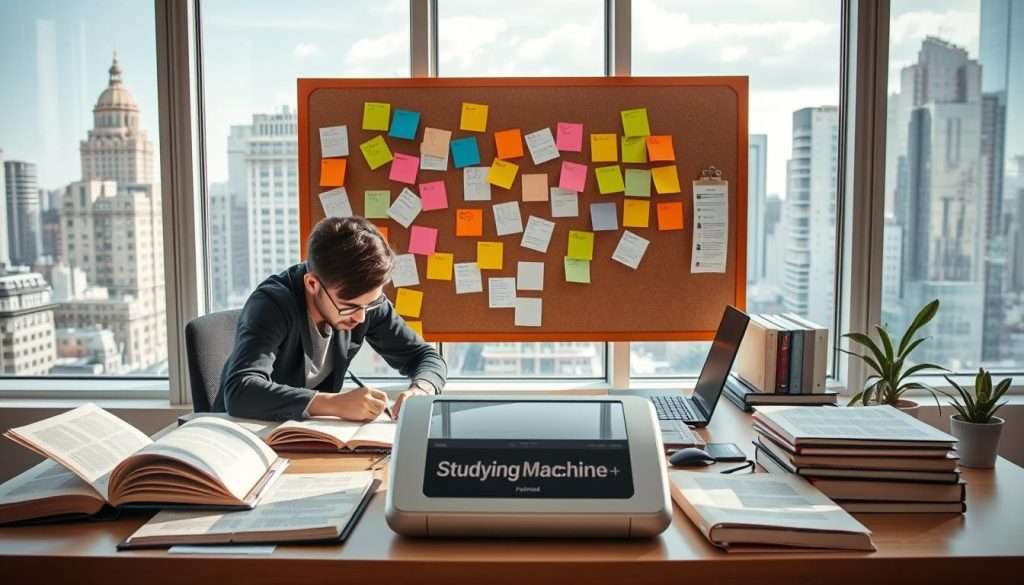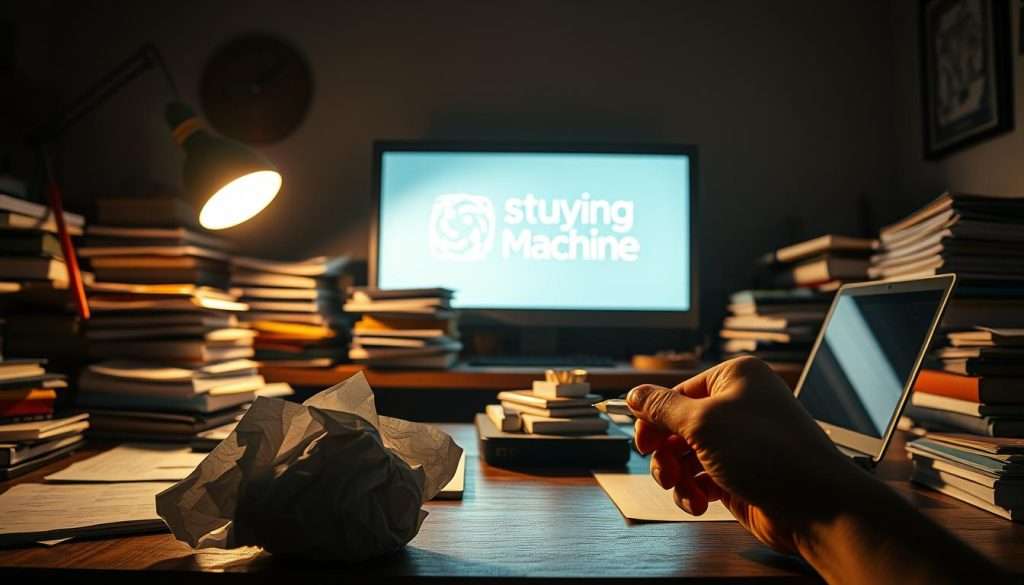Ever noticed how unfinished tasks keep popping up in your mind? It’s hard to move on to new tasks. This is the Zeigarnik effect at work. It’s named after psychologist Bluma Zeigarnik. She found our brains remember unfinished tasks better than the ones we finish.
Grasping the Zeigarnik effect can change how you work and remember things. It helps you manage tasks better and reach your goals faster.
Key Takeaways
- Understand the psychological basis of the Zeigarnik effect.
- Learn how to apply the Zeigarnik effect to enhance productivity.
- Discover strategies to improve memory using the Zeigarnik effect.
- Explore practical examples of the Zeigarnik effect in daily life.
- Find out how to balance task completion with the Zeigarnik effect.
What Is the Zeigarnik Effect?
Ever found yourself thinking about a task you didn’t finish? This is the Zeigarnik effect. It shows why we remember unfinished tasks better than ones we’ve completed.
The Psychology Behind Unfinished Tasks
The Zeigarnik effect creates a mental tension when we start but don’t finish tasks. This tension makes us remember these tasks more. Our brains handle unfinished tasks in a special way.
When we start a task, our brain keeps working on it until it’s done. This is why we can’t stop thinking about unfinished tasks.
For example, imagine you’re reading a suspenseful novel and stop at a cliffhanger. You can’t stop thinking about what happens next. This is the Zeigarnik effect at work. Your brain is trying to figure out the story.
How It Affects Our Mental Processes
The Zeigarnik effect greatly affects how we remember and prioritize tasks. It can be both good and bad. It helps us remember important tasks but can also cause mental clutter if we have too many.
| Aspect | Description | Impact |
|---|---|---|
| Cognitive Tension | Mental state created by unfinished tasks | Increased memory recall |
| Mental Loops | Brain’s way of keeping track of incomplete tasks | Enhanced task prioritization |
| Mental Clutter | Accumulation of unfinished tasks in the mind | Potential for increased stress |
Knowing about the Zeigarnik effect can help us use its benefits and avoid its downsides. By understanding how our brains work, we can better manage our tasks.
The History and Discovery of the Zeigarnik Effect
In the early 20th century, a Russian psychologist named Bluma Zeigarnik made a key discovery. She noticed that waiters in a café remembered orders until they were finished. But once the task was done, the details were forgotten. This sparked her interest in how unfinished tasks affect our minds.
Bluma Zeigarnik’s Original Research
Bluma Zeigarnik’s research in the 1920s was groundbreaking. She did experiments to see how people remember uncompleted tasks better than finished ones. Her findings showed that unfinished tasks create tension, making them stick in our memory. This phenomenon was named the Zeigarnik effect in her honor.
Evolution of the Concept in Cognitive Psychology
Over time, the Zeigarnik effect has been studied a lot in cognitive psychology. Researchers have looked into its effects on memory, task management, and productivity. The idea has grown to include how our brains handle tension and loops, giving us insights into how we process information.
| Year | Researcher | Key Findings |
|---|---|---|
| 1927 | Bluma Zeigarnik | Unfinished tasks are remembered better than completed ones. |
| 1950s | Cognitive Psychologists | Explored the Zeigarnik effect in the context of cognitive dissonance. |
| 2000s | Modern Researchers | Applied the Zeigarnik effect to task management and productivity strategies. |
The Science of the Zeigarnik Effect
The Zeigarnik effect is a fascinating area of study. It shows how our brains handle unfinished tasks. This creates a sense of discomfort that pushes us to finish what we started.
Cognitive Tension and Mental Loops
Cognitive tension happens when we have unfinished tasks. It makes our minds loop back to the task, using up mental energy. Knowing this can help us use the Zeigarnik effect to get more done and remember better.
The Neuroscience of Incomplete Tasks
Studies in neuroscience reveal that unfinished tasks activate our brain’s default mode network. This leads to more thinking about the task, using up mental resources. This activity also releases stress hormones, which can either help or hinder us, depending on the situation.
Connection to Cognitive Dissonance
The Zeigarnik effect is also tied to cognitive dissonance. This is a feeling of discomfort from conflicting ideas or unfinished tasks. Our brain tries to fix this by finishing the task or finding a way to make it okay. Using this knowledge, we can find ways to work better and feel less stressed.
Understanding the Zeigarnik effect can greatly improve our lives. It can help us be more productive and remember things better. As we learn more about it, we’ll see how to use it to reach our goals.
Memory Enhancement Techniques Using the Zeigarnik Effect
Unlock better recall and memory retention with the Zeigarnik effect’s innovative approach. By interrupting study sessions or tasks, you can harness the power of cognitive tension to improve your memory.
Strategic Interruption for Better Recall
One effective way to apply the Zeigarnik effect is through strategic interruption. This involves breaking up study sessions or tasks into intervals. This allows you to capitalize on the cognitive tension that arises from unfinished tasks.
For example, when studying for an exam, divide your study material into smaller chunks. Take breaks in between. This technique helps prevent mental fatigue and keeps your brain engaged.
To implement strategic interruption, try the following:
- Break down large tasks into smaller, manageable chunks
- Set specific intervals for work and breaks
- Use a timer to keep yourself on track
- Review and adjust your intervals as needed
Study Methods for Students
Students can particularly benefit from the Zeigarnik effect by incorporating it into their study routines. By applying the principles of cognitive tension, students can enhance their memory retention and improve their overall learning experience.
The Suspended Learning Technique
The suspended learning technique involves stopping your study session at a strategic point, leaving a task unfinished. This could mean stopping in the middle of a problem or pausing at a critical point in your reading material. When you return to your study session, you’ll be able to pick up where you left off more easily, thanks to the cognitive tension created by the unfinished task.
Memory Retention Through Task Switching
Another effective study method is task switching. This involves switching between different types of material or tasks to keep your brain engaged. For example, if you’re studying for multiple exams, you can switch between subjects to create cognitive tension and improve memory retention.
Here’s an example of how to apply task switching:
- Identify multiple tasks or subjects to switch between
- Create a schedule to alternate between tasks
- Use a timer to keep yourself on track
- Review your progress and adjust your schedule as needed
By incorporating these techniques into your study routine, you can harness the power of the Zeigarnik effect to improve your memory retention and achieve better academic results.
Boosting Productivity with Interrupted Tasks
Using the Zeigarnik effect can greatly improve your productivity. It lets you start tasks without feeling you must finish them. This method might seem odd, but it works well against procrastination and boosts productivity.
Starting Tasks Without the Pressure to Finish
The Zeigarnik effect is great because it lets you start tasks without worrying about finishing them. This is especially useful for big or complicated projects that often cause delay.
To use this technique, break down tasks into smaller parts. Start with the first part without worrying about the rest. This keeps you focused and motivated to keep going.
Overcoming Procrastination
Procrastination is a big barrier to productivity. The Zeigarnik effect is a strong tool to beat it by creating productive tension.
The Two-Minute Rule
The Two-Minute Rule is a helpful strategy. If a task takes less than two minutes, do it right away. This rule makes it easier to start tasks you might otherwise delay.
Creating Productive Tension
Another way is to start a task and then stop yourself. Use a timer or plan a break. This makes you think about the task, making it easier to come back to it later.
| Strategy | Description | Benefit |
|---|---|---|
| Two-Minute Rule | If a task takes less than two minutes, do it immediately. | Reduces procrastination by simplifying task initiation. |
| Creating Productive Tension | Start a task, then interrupt yourself to create a mental loop. | Enhances engagement and motivation to return to the task. |
By using these strategies, you can tap into the Zeigarnik effect to increase your productivity and fight procrastination. The key is to start tasks without feeling you must finish them. This creates a mental drive that pushes you to keep going.
Practical Applications of the Zeigarnik Effect in Daily Life
Let’s see how the Zeigarnik effect can help in your daily life. It’s not just for theory; it’s useful in managing tasks, improving memory, and boosting productivity.
Work Environment Strategies
In the workplace, the Zeigarnik effect can change the game. Leaving tasks unfinished or interrupting them can keep you focused and motivated. For example, ending a task mid-way can make it easier to start again the next day.
This trick is great for tasks needing lots of concentration or creativity.
Here are some ways to use the Zeigarnik effect at work:
- Break big projects into smaller tasks. Leave one unfinished at each session’s end.
- Use tools that let you pick up where you left off easily.
- Make a “to-do” list with tasks that are specific but can be interrupted.

Personal Development Applications
The Zeigarnik effect also helps in learning new skills or hobbies. Starting a new activity without finishing it makes learning less scary and more fun. For instance, learning a new language can be more exciting if you stop at a cliffhanger.
Here are some ways to apply it to personal development:
- Start a new book or course and pause at an interesting point to keep the excitement alive.
- Begin a new hobby with a project that leaves you curious about what’s next.
- Use the Zeigarnik effect to build a habit by starting small and stopping at a point that makes you want to continue.
Digital Tools That Leverage the Effect
Many digital tools can help you use the Zeigarnik effect. Tools like project management software, to-do lists, and learning apps can boost productivity and engagement.
| Tool Type | Examples | How It Leverages the Zeigarnik Effect |
|---|---|---|
| Project Management Software | Trello, Asana | Allows you to break down tasks and leave them at a point where you’re eager to continue. |
| To-Do Lists | Todoist, Wunderlist | Helps you create and manage tasks, keeping you engaged with unfinished tasks. |
| Learning Apps | Duolingo, Coursera | Structures learning into bite-sized chunks, often leaving you wanting to continue the next lesson. |
By using the Zeigarnik effect in your daily life, you can boost productivity, improve memory, and make the most of digital tools.
Measuring and Tracking Your Results
It’s important to know how well the Zeigarnik effect works. We need to pick specific metrics to see its impact on memory and productivity.
Memory Improvement Metrics
To check the Zeigarnik effect’s impact on memory, we can look at a few things. These include:
- Recall Rate: How often do you remember tasks or information without looking at notes?
- Memory Retention: How well do you retain information over time?
Tracking these metrics shows how the Zeigarnik effect helps improve our memory.
Productivity Tracking Methods
For productivity, we can track a few things. These are:
- Task Completion Rate: How many tasks do you complete within the set timeframe?
- Time Spent on Tasks: Are you spending less time on tasks after applying the Zeigarnik effect?
These metrics help us see how the Zeigarnik effect boosts our productivity.
Adjusting Your Approach Based on Results
After tracking our metrics, we can adjust our approach. If our recall rate goes up but task completion doesn’t, we might need to change things. This could mean adjusting how often we interrupt ourselves or the type of tasks we use the Zeigarnik effect for.
By always measuring and adjusting, we can get the most out of the Zeigarnik effect in our daily lives.
Potential Challenges and How to Overcome Them
The Zeigarnik effect can boost your memory and work efficiency. Yet, it also has downsides. You might face obstacles when using it daily. It’s important to tackle these challenges to get the most out of it.
Mental Fatigue and Anxiety
Using the Zeigarnik effect can lead to mental tiredness and stress. Constantly leaving tasks undone or interrupting your work can cause unease. It’s key to find a balance between using this effect and taking breaks.
Strategies to reduce mental fatigue:
- Practice mindfulness and meditation to calm your mind
- Set aside dedicated time for relaxation and leisure activities
- Prioritize tasks and focus on the most critical ones first
Finding the Right Balance
It’s vital to find the right balance with the Zeigarnik effect. You must figure out how many tasks to keep open and how often to interrupt yourself. Trying different methods can help you find what works best for you.
| Task Type | Frequency of Interruption | Effectiveness |
|---|---|---|
| Complex tasks | Every 60 minutes | High |
| Simple tasks | Every 30 minutes | Moderate |
| Creative tasks | Every 90 minutes | High |
When Not to Use the Zeigarnik Effect
There are times when you shouldn’t use the Zeigarnik effect. For example, during tasks that need your full attention or when you’re under a lot of pressure. It’s also not good for people who easily get anxious or struggle with stress.
“The mind is not a vessel to be filled, but a fire to be kindled.” – Plutarch
By knowing the challenges and how to overcome them, you can use the Zeigarnik effect wisely. This way, you can enhance your memory and work efficiency while keeping your mind healthy.

Conclusion: Making the Zeigarnik Effect Work for You
We’ve looked into the Zeigarnik effect, a powerful tool for you. It helps you remember and get things done better. This means you can reach your goals faster.
The Zeigarnik effect is not just a theory. It’s a useful strategy for everyday life. It helps students and professionals alike. It can really change the game for you.
When using the Zeigarnik effect, keep track of how it works for you. Adjust your methods as you go. With regular use, you’ll see big improvements. The trick is to make it a part of your daily life.
This way, you can use unfinished tasks to your advantage. Start using the Zeigarnik effect today. See how it makes you more productive and efficient!

